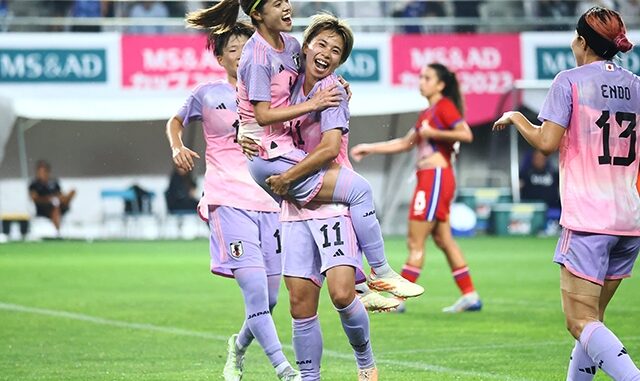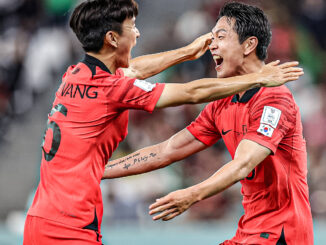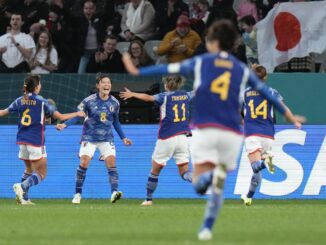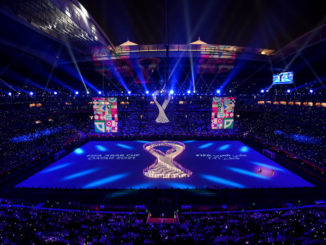

Japan boss Futoshi Ikeda is set to introduce his brand of Nadeshiko football to the world at Australia and New Zealand 2023.
After a series of tournament underperformances, the 2011 champions are out to reclaim their reputation as a global powerhouse of women’s football.
Heading into the tournament, Japan’s form of late has been mixed, but they’re finally showing signs that the efforts of the past two years under Ikeda may well come to fruition sooner rather than later. There are no major injuries to be concerned with and the vast majority of the players selected have been standout performers at club level over this past season.
Public broadcasters NHK secured broadcast rights for Japan’s three group stage matches after drawn out negotiation process. The deal was concluded just one week before the opening day as many were left fearing a World Cup blackout may become a reality.
At the time of writing Japan has nothing in place for the knockout stages but it is reasonable to assume that matches will be acquired on an ad-hoc basis until Japan go no further in the competition – or win the whole thing.
THE SQUAD
On 13 June, Japan announced its final 23-member squad heading to New Zealand in mid-July. The Nadeshiko will be one of the fresher faced sides with 13 debutants and an average age of 24.8 years, the fourth youngest at the tournament behind Haiti (22.5), Zambia (23.6) and Panama (24.6).
To the surprise and disappointment for many, prolific forward Mana Iwabuchi has been left out of the roster and will not be appearing in what would have been her fourth World Cup.
Over the past season the 30-year-old has struggled for form and minutes, and now finds herself outside of Ikeda’s plans. His focus seems to be on youth and building a physically robust side with the future very much in mind.
WE League Golden Boot winner Riko Ueki (Tokyo Verdy Beleza) and Maika Hamano (Hammarby) are the interchanging number 9s with Hinata Miyazawa (Mynavi Sendai) and Aoba Fujino (Tokyo Verdy Beleza) as the wide forwards.
Further back Manchester City’s Yui Hasegawa will be the creative spark in midfield together with Liverpool’s Fuka Nagano. There is no shortage of depth out wide with NWSL stars Hina Sugita (Portland Thorns) and Jun Endo (Angel City) vying for the left wing-back spot, and Risa Shimizu (West Ham) and Kiko Seike (Urawa Reds) available on the opposite side.
The back-three system is here to stay and so a hearty helping of centre-backs is in order. Captain Saki Kumagai (AS Roma) will be at the base of defence, with Moeka Minami (AS Roma) and Shiori Miyake (INAC Kobe) on either side. The physically dominant Hana Takahashi (Urawa Reds) may also be called upon to provide cover or if a change of profile is needed.
Three of Ikeda’s U20 side that reached the 2022 U20 Women’s World Cup final last August have now made the grade at senior level; Fujino, Hamano and Rion Ishikawa (Urawa Reds) all impressing at club level and earning the trust of the Nadeshiko boss.
KEY PLAYER – YUI HASEGAWA
From the holding midfield position, Hasegawa plays a crucial role both in chance creation and in recoveries. She will receive the ball from deep and look to progress with rapid link-up play or her dynamic dribbling skills. She is relentless, yet clinical, in the tackle and her off-the-ball work should not be ignored.
Hasegawa began life as an attacking midfielder but has adjusted well to the No.6 role she is required to play at Manchester City. Ikeda has followed suit at international level and deploys her in the heart of the Nadeshiko engine room. Her versatility could allow her to provide cover further up the pitch should the need arise.
Embed from Getty ImagesONE TO WATCH – AOBA FUJINO
Fujino was a standout performer for Ikeda at the U20 World Cup last year.
She plays as a right-sided wide forward, usually in a front three. She excels at wing-play and will often run in-behind to play in a teammate or advance on goal herself. She is also a clinical finisher can shoot using either foot with accuracy both at close range or from distance. She tallied a total of 11 goals and eight assists over the 2022/23 season with her WE League side Beleza.
Following on from the U20 World Cup, Ikeda has involved Fujino in all nine senior matches played since, of which the youngster has made six starts and three substitute appearances.
Preparations thus far suggest that she is first choice as the right-sided attacker alongside club teammate Riko Ueki.
THE MANAGER – FUTOSHI IKEDA
Since taking the helm in October 2021, Futoshi Ikeda has shaped this Nadeshiko side to suit his approach, with a keen preference for youth and succession planning.
Thus far the former Urawa Reds defender has guided Japan to a semi-final finish at the 2022 AFC Women’s Asian Cup, a first-placed finish at the EAFF E-1 Women’s Football Championship of the same year and a second-placed finish at the 2023 edition of the She Believes Cup. This will be Ikeda’s first World Cup campaign as manager of the Nadeshiko seniors.
Embed from Getty ImagesThe 52-year-old has also commandeered two U20 Women’s World Cup campaigns in 2018 and 2022, finishing first and second respectively. He has demonstrated a clear preference for players who have performed well for him at this level with several making the cut for the trip down under; Fuka Nagano, Maika Hamano, Aoba Fujino and Rion Ishikawa are all good examples.
Ikeda’s win ration as Japan boss currently stands at 52.28% with 11 wins, three draws and seven defeats. This, more or less, matches that of his predecessor Asako Takakura who managed 52.31% over 60 games in five years and four months in charge. Given the emphasis on youth and future planning it is likely that Ikeda’s ratio will only improve moving forward.
His in-game management is perhaps one area that could draw criticism. All too often Japan dominate possession without finding the net and are eventually picked off by a breakaway goal. When going behind they generally struggle to find a way back into games and have managed to overturn a deficit on just two occasions under Ikeda.
Using his bench as a means of changing a game would certainly go a long way here.
THE SYSTEM – 3-4-2-1
Possession and fluidity are the core concepts of Nadeshiko football. On the global stage they often struggle for physical superiority and so play around this disadvantage with intricate passing and rapid off-the-ball movement. Ikeda has implemented a system that plays into those ideals.
In its most positive form, playing three at the back allows Japan to push up high with numbers committed. Wingbacks Hina Sugita and Risa Shimizu provide the width and are key in chance creation, be it a cross, dribble or overlapping run. As a whole the forward lines will open up defences with passing combinations and attempts to drag defenders out of position with runs into space.

Riko Ueki is likely to start as the focal point striker with Hinata Miyazawa and Aoba Fujino on either side of the attack. Although all three have produced the goods at club level this season, Japan has lacked a clinical edge of late and goals have been hard to come by.
From the five games they have played against fellow World Cup opposition in 2023 they have scored a total of just five goals and managed an average xG of 1.56. Evidently there are issues in converting the viable chances they create.
At the opposite end, Saki Kumagai will command the backline with Shiori Miyake and Moeka Minami on either side to complete the back three. When pitted against opposition with pace and quality up front, Ikeda often opts to play deep with the wingbacks given less license to advance forward.
Here the formation takes the form of a back five rather than a back three. From the previously mentioned five game sample size Japan have conceded five goals with an xGA of 0.84 — par for the course.
There isn’t much to suggest Ikeda has an alternative formation ready for when things head south. Three at the back has become a defining characteristic of his tenure and he is known to focus the passage of play through different parts of the pitch to match the opponent as opposed to rejigging the shape.
For example, Hina Sugita may fall into the backline while her right-sided counterpart Risa Shimizu will push high and offer overlapping support if Japan are better matched to their opponent on that side. The direction of play and individual positional role, rather than the formation, is adapted to the situation at hand.
PREDICTION
Although Japan boasts technical talent in abundance, this is in fact a young, fresh-faced squad that are yet to cut their teeth on the grand stage.
Early signs indicate that efforts made in preparation are coming to fruition and an end product is gradually falling into place. But as is often the case with tournament football, experience can be crucially important when reaching the latter stages.
Embed from Getty ImagesQualification from Group C should come with little hindrance provided Japan avoid complacency in their first match against Zambia and pacey forward Barbra Banda is well accounted for.
They are paired with Group A and will likely face either Norway or Switzerland in the Round of 16. Both of these sides will surely bring challenges but ultimately Japan should feel confident given its attacking prowess and depth in quality.
From there things get tricky. If Japan top Group C they will likely meet either Holland or Sweden in the quarter finals considering the probable tournament path. Should they finish second then they will be pitted against world champions USA in the quarters.
All three of these sides rank higher than Japan in the FIFA standings and all three beat Japan in their previous meeting. While there is every chance Japan could produce a winning performance, the likely outcome is that this Japan side would fall after a valiant display. Considering Ikeda’s emphasis on youth and future planning, however, the JFA would likely deem this an acceptable finish all things considered.
Establishing what needs to be done to reignite the country’s love for women’s football would be to pose a very different, yet equally as pressing, question.
Embed from Getty ImagesWhilst a quarter final exit might be acceptable from a performance standpoint it will likely do little to capture the attention of the masses. If they were to go one step further and reach the semi-finals the result could be quite different, however.
Regardless of the outcome in the semis, Japan would play the maximum number of games possible given that they would advance to the third place playoff should they lose and, of course, would book themselves a place in the final should they emerge triumphant.
In getting this far they would inevitably have eliminated at least one opponent currently ranked higher in the global standings and the prospect of reaching the podium, even as third place finishers, might just be enough to galvanise the nation.
MATCHES
Zambia vs Japan – 22 July, Hamilton
Japan vs Costa Rica – 26 July, Dunedin
Japan vs Spain – 31 July, Wellington
Photo: JFA
Listen to The Asian Game Podcast as we preview Japan’s chances at this FIFA Women’s World Cup




